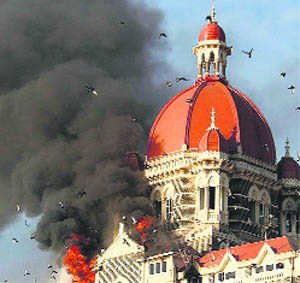Ajay Banerjee
Tribune News Service
New Delhi, November 26
Nation pays homage to 166 people, including 18 security personnel, killed in the terror act

Seven years after the November 2008 Mumbai terror attacks, the often-blamed bureaucratic ‘red tape’ is in full play and holding back a crucial legislation, while all Indian fishing boats still do not carry any automatic identification system — literally a nightmare for security agencies.
Despite various meetings, the security infrastructure and the related network to enforce the rule of law at sea which was planned after the Mumbai attacks is still incomplete. Creditably, some aspects of surveillance at sea have been and are backed by high-end technology – the very latest. Ten-armed terrorist came by the sea route to simultaneously attack five different locations in Mumbai on the night of November 26, 2008, killing 166 persons.
Immediately after the attacks the UPA-I government (May 2004 to May 2009) headed by Manmohan Singh issued an executive order that made the Indian Navy as over all in charge of coastal security. To date, the Navy is not legally empowered to take action against suspicious vessels. A coastal security Bill is doing the usual rounds of discussions.
Two years ago in December 2013, a draft coastal security Bill was prepared which earmarked responsibilities and duties of 10 central and state agencies security involved in coastal security. The Bill was sent to the Union Home Ministry for piloting it to Parliament after consulting the coastal states. The Bill will address aspects related to jurisdictions, maritime zones and the role of agencies involved in coastal security. It lay down powers of all agencies with the Navy in the lead.
The other key issue pending is of installation of an automatic identification system (AIS) on all boats. For boats that are less than 20 metres in length, the proposal to have an AIS is still in the phase-I and is being implemented in Gujarat and Tamil Nadu at a cost of Rs 333 crore.
The AIS is basically a transponder fitted onto a boat. The transponder constantly emits a signal that is unique to the boat and the same is picked up by ground-based radars and AIS receivers. The signal identifies the boat. With this system, it means the Navy and the Coast Guard are grappling to deal with thousands of unidentified boats. Fishing boats bigger than 20 metres anyway have the AIS.
On the positive side, a chain of 46 coastal radars and 74 AIS receivers is in place. The National Command Control Communication and Intelligence Network with the Information Management Analysis Centre at Gurgaon is operational. A total of 51 nodes of the Navy and Coast Guard are integrated — all to provide a comprehensive maritime domain awareness. Biometrics have been collected from 67.5 lakh people in 3331 coastal villages. The second phase of an additional 46 coastal radars is on track.
Meanwhile, The Israeli Ambassador to India Daniel Carmon today said the 26/11 attacks remind us all the threat of extremist terror against democracies and the free world by those who are committed to the killing of people who do not share their fanatic mindset and views. The Chahbad house –prayer house of Jews— in South Mumbai was one of the targets on 26/11.
Crucial Bill caught in red-tape
Immediately after the 2008 Mumbai attacks, the UPA-I government made the Navy as over all in charge of coastal security. To date, the Navy is not legally empowered to take action against suspicious vessels
A draft coastal security Bill prepared to earmark responsibilities of 10 central and state agencies security involved in coastal security has been caught in red-tape since 2013
The other key issue pending is of installation of an automatic identification system (AIS) on all boats. For boats less than 20 metres in length, the proposal to have an AIS is still in phase-I
